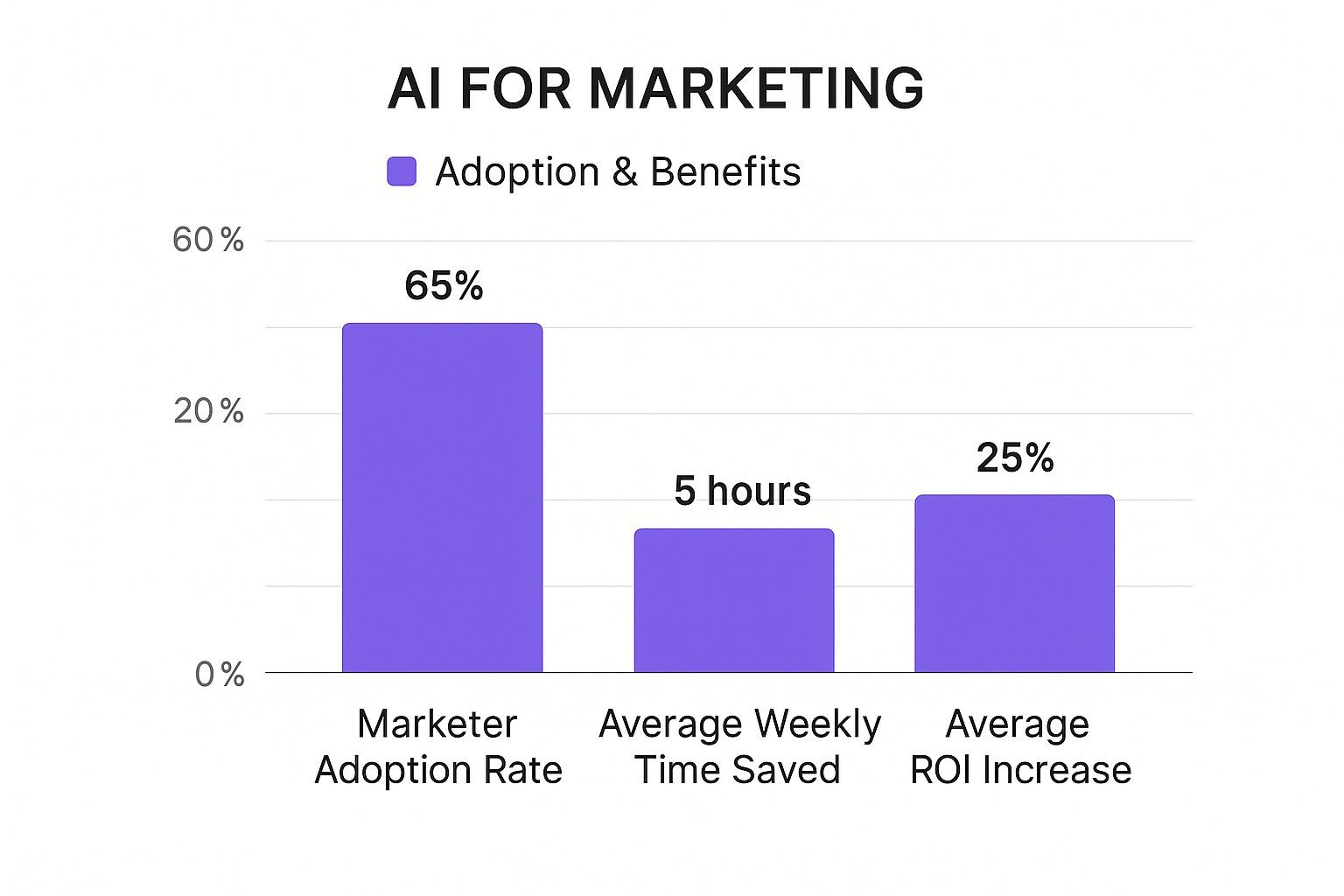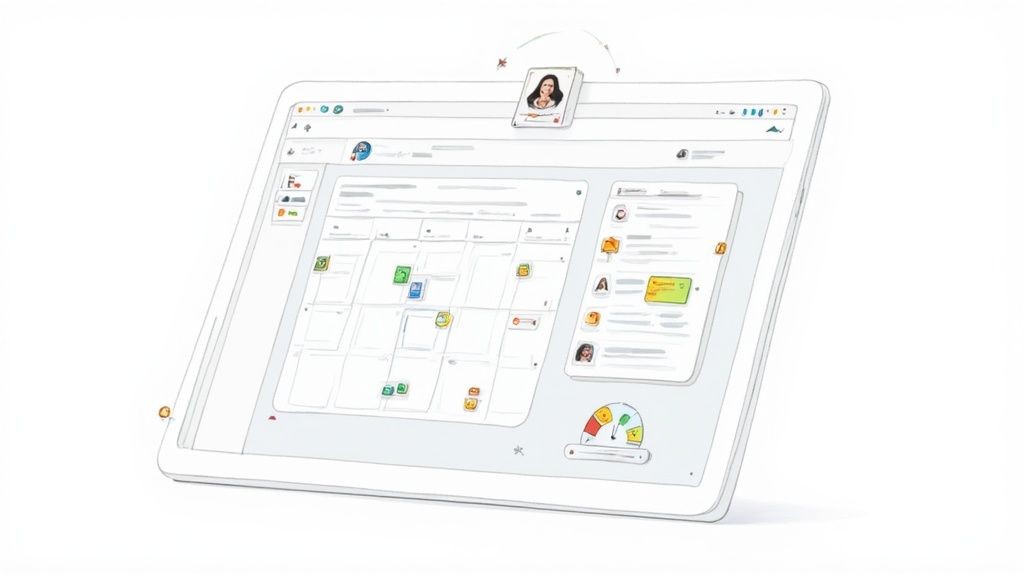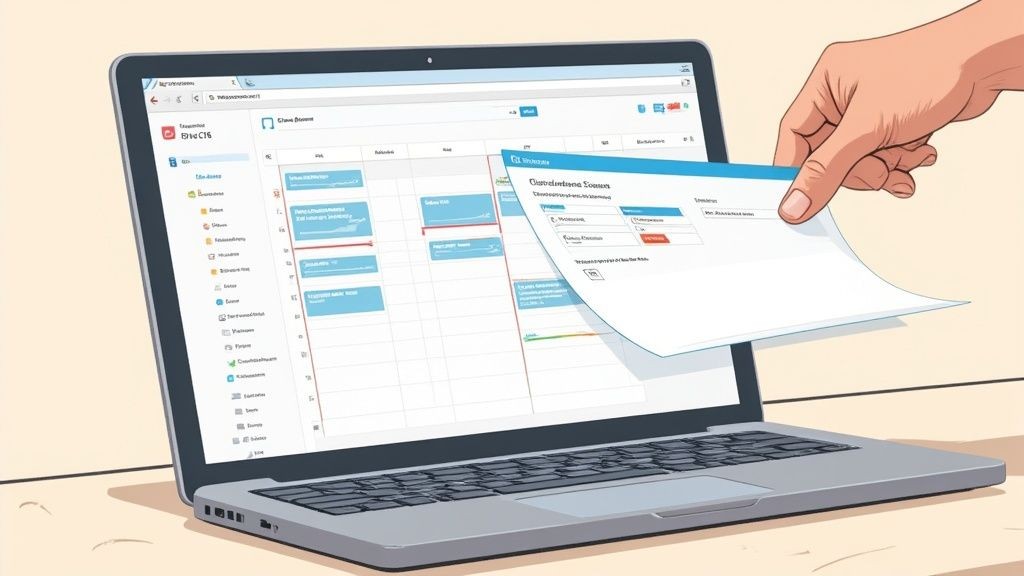Picture this: you're trying to conduct an orchestra, but every musician has a different sheet of music. That’s what marketing without a central calendar feels like - chaotic, misaligned, and just asking for trouble.
Calendar marketing software is the conductor's podium. It's the single source of truth that gets every part of your marketing team playing in perfect harmony.
What Is Calendar Marketing Software
Instead of digging through endless email chains or staring at outdated spreadsheets, this software gives you a dynamic, visual overview of every single marketing activity. It's built from the ground up to solve the common headaches that plague modern marketing teams.
Transforming Chaos into Clarity
At its heart, a marketing calendar is all about creating order. It helps teams see the big picture, preventing campaign overlaps and spotting content gaps before they turn into real problems. This kind of visibility is a game-changer for a few key reasons:
- Better Team Alignment: When everyone can see the same plan, collaboration just clicks. Writers, designers, and social media managers can sync up their efforts without needing constant meetings to stay on the same page.
- Smarter Strategic Planning: A clear overview lets you shift from reactive, last-minute scrambles to proactive, long-term strategy. You can map out your quarterly goals and make sure every single activity is pushing you closer to them.
- Crystal-Clear Accountability: With tasks assigned and deadlines visible to everyone, there’s no confusion about who is responsible for what. The risk of missed deadlines drops dramatically.
Still not convinced? The numbers speak for themselves.

These figures show that this isn't just about getting organized. It's about getting back precious time and driving real, measurable growth.
To put it simply, these platforms tackle some of the most persistent problems marketers face daily.
Here’s a quick look at how they solve those common pain points:
Key Problems Solved by Calendar Marketing Software
| Common Marketing Challenge | How Calendar Marketing Software Solves It |
|---|---|
| Siloed Teams & Miscommunication | Creates a single, shared view of all activities, ensuring everyone is on the same page and working toward common goals. |
| Inconsistent Content & Campaign Timing | Visualizes the entire marketing schedule, making it easy to spot gaps, prevent overlaps, and ensure a consistent brand message. |
| Lack of Visibility into the Big Picture | Moves planning out of scattered documents and into a unified dashboard, connecting daily tasks to overarching strategic objectives. |
| Difficulty Tracking Progress & Deadlines | Provides clear task assignments, deadlines, and status updates, making it simple to monitor progress and hold team members accountable. |
| Wasted Time on Manual Coordination | Automates notifications and centralizes communication, cutting down on the endless meetings and email threads needed to keep projects moving. |
As you can see, the right software doesn't just put dates on a grid; it fundamentally changes how your team operates for the better.
More Than Just a Schedule
While planning is a massive piece of the puzzle, modern calendar marketing software goes way beyond that. It's the central hub that connects your strategy directly to your execution.
The industry's growth story really tells you everything you need to know. The global market, valued at USD 386.7 million, is on track to blow past USD 1.5 billion by 2037, all thanks to the worldwide shift to digital-first marketing. You can dig into more of the data on this market growth over at Research Nester.
A great marketing calendar doesn't just tell you what is happening; it shows you why it's happening and connects every activity back to a larger strategic goal. It’s the bridge between your team's daily tasks and your company's revenue targets.
Ultimately, these tools give you the structure you need for creativity and efficiency to actually work together. And when you integrate tools like our own Add to Calendar PRO, you close the loop between planning an event and making sure your audience shows up, turning your calendar into a powerful engagement engine.
The Core Features That Power Modern Marketing
While the feature list for every calendar marketing software can look a little different, the best ones all share the same DNA. They're built to be much more than simple schedulers; they become active partners in getting your marketing done. These core features are the real engine that drives a well-oiled marketing machine, turning abstract strategies into stuff you can actually see and measure.
Think of it like this: a home cook can get by with one good knife and a cutting board. But a professional chef? They have a whole toolkit, with specialized gear for every single task. A modern marketing calendar is your professional-grade toolkit.
Centralized Campaign and Content Planning
The absolute bedrock of any good platform is a centralized planning hub. This is your mission control. It gives you that crucial, bird's-eye view of every campaign, blog post, social push, and promotion happening across all your channels. It’s where you can finally see how your big product launch connects to next week’s email newsletter and the social media blitz that follows.
Having this single source of truth is a game-changer. A recent study found that a staggering 56% of marketers are worried about burning out. A huge part of that stress comes from a chaotic, disorganized planning process. A central calendar tackles that problem head-on by bringing clarity and order to the chaos.
A great calendar doesn't just show you deadlines; it reveals the story of your marketing strategy over time. It helps you connect the dots between different initiatives, ensuring a cohesive customer experience rather than a series of disconnected messages.
This clarity gets rid of the guesswork and helps teams build campaigns that actually feel connected.
Visual Workflow and Task Management
Seeing the big picture is one thing, but managing the day-to-day grind is another. This is where visual workflows, usually in the form of Kanban boards or project timelines, come into play. These tools chop up huge campaigns into bite-sized stages - like "To Do," "In Progress," and "Approved" - so anyone can see the status of a task with a quick glance.
This visual approach goes hand-in-hand with built-in task management. You can assign specific jobs to people on your team, pop in a deadline, and attach all the necessary files or creative briefs right there in the calendar. The result is crystal-clear accountability.
For instance, a single calendar item for a "New Webinar" campaign could hold everything:
- Task: Draft promotional email (Assigned to: Sarah, Due: Monday)
- Task: Design social media graphics (Assigned to: David, Due: Tuesday)
- Task: Set up event registration page (Assigned to: Maria, Due: Wednesday)
This level of detail means things stop falling through the cracks, and the project keeps moving forward.
Automation and Seamless Integrations
Here’s where modern calendar marketing software really starts to shine: automation and integrations. These are the features that take care of all the repetitive, manual work that eats up a marketer’s day, giving you that time back for creative thinking and big-picture strategy.
Workflow automation can streamline things like approval processes, automatically pinging a manager when a blog post is ready for review. No more bottlenecks or endless "just following up" emails. At the same time, solid integrations with your other marketing tools create a truly connected system.
For example, our service, Add to Calendar PRO, slots perfectly into these workflows. A team can plan a webinar in their calendar and, using our API, automatically generate all the "add to calendar" links they need for their emails and landing pages. Everything stays perfectly in sync.
By hooking your calendar up to your email platform, social media scheduler, and CMS, you create a smooth flow of information that saves a ton of time and cuts down on the chance of human error.
The Strategic Payoff of a Unified Marketing Calendar

Bringing in a solid calendar marketing software is a whole lot more than just tidying up your schedule. It’s a genuine strategic shift that delivers real business results. We're not talking about making things look pretty; we're talking about building a smarter, more coordinated, and far more effective marketing engine.
Think of it like this: you can have a bunch of talented solo musicians, or you can have a symphony orchestra. Separately, their work might be great. But when they all play from the same sheet music - your unified calendar - they create something truly powerful and cohesive.
Finally Achieve Total Marketing Visibility
The first thing you'll notice is the incredible clarity. No more jumping between siloed spreadsheets for content, separate planners for social media, and random notes for email campaigns. Everything lives in one place. This single source of truth gives you a bird's-eye view of your entire marketing operation.
Suddenly, your team can see the whole forest, not just the individual trees. You can spot glaring gaps in your buyer's journey or realize you’re accidentally spamming your audience during a specific week. A recent study found that 56% of marketers worry about burnout, with a lot of that stress coming from chaotic planning. A unified calendar is the perfect antidote, cutting through the noise and lighting up a clear path forward.
Foster Real Cross-Team Alignment
When everyone is literally on the same page, real collaboration happens almost automatically. The content team knows exactly when social needs assets. The email team sees product launches weeks in advance. This shared view gets rid of so many of those "just checking in" meetings and redundant email chains.
This alignment has a direct impact on your team's output. For example, a unified calendar ensures that:
- Messaging stays consistent across every channel, which strengthens your brand.
- Campaigns feel cohesive, with each piece building on the last one.
- Team handoffs are smooth, preventing those classic bottlenecks and missed deadlines.
A unified marketing calendar is a silo-buster. It turns a group of individual marketers into a single, goal-driven team where everyone sees how their piece fits into the bigger picture.
This kind of environment makes it easy to be agile. Teams can pivot together based on what’s happening in real-time, instead of waiting for information to slowly trickle down through different departments.
Empower Data-Driven Decisions and Actually Prove ROI
This is the big one. A centralized marketing calendar is your secret weapon for making decisions based on data, not guesses. When every campaign is planned and tracked in one system, you can draw a straight line from your efforts to your results. You can see which content types are killing it, which channels drive the most engagement, and how different campaigns play off each other.
This trove of data lets you optimize your strategy with surgical precision. You can shift budget to the stuff that's working and tweak what isn't. But more importantly, it gives you the power to clearly show the return on investment (ROI) of your marketing.
By linking specific calendar activities to your key performance indicators (KPIs), you can build an undeniable case for your budget and your strategy. You're no longer just saying your marketing works; you have the organized data to prove it. Your calendar just became one of your most powerful analytical tools.
Integrating Your Calendar with Your MarTech Stack
Your marketing calendar is most powerful when it stops being an isolated island and starts talking to the other tools you use every day. Think of it as the central nervous system for your marketing technology (MarTech) stack - it should connect everything, making sure information flows from one platform to another without you having to lift a finger.
This connectivity is what separates a simple scheduler from a true piece of calendar marketing software. When your calendar integrates with tools like your social media scheduler, a CMS like WordPress, or an email platform like Mailchimp, you create a seamless, automated ecosystem. That right there eliminates countless hours of tedious, repetitive work.
The Power of a Connected Workflow
Picture this: you mark a blog post as "published" on your marketing calendar. Instantly, that one click triggers a chain reaction. An email announcing the new post is automatically sent to your subscribers, and a series of promotional posts are scheduled across all your social media channels.
This isn't some futuristic fantasy; it's the reality of a well-integrated workflow. By connecting your tools, you build a system where the calendar acts as the command center, orchestrating your entire campaign. It’s a core reason why the demand for marketing automation is surging. You can find out more about the key growth drivers in this market research report.
An integrated calendar turns your marketing plan into a set of automated instructions. It ensures every step of a campaign is executed on time and in the right sequence, slashing the risk of human error and freeing up your team for more strategic work.
This level of automation is absolutely critical if you want to scale your marketing efforts without burning out your team.
Bridging Planning and Audience Action
Integrations don't just streamline your internal work; they also create a much more direct path to your audience. This is where a service like ours, Add to Calendar PRO, really shines. We designed it to fit perfectly within this connected ecosystem, bridging the gap between your marketing plans and getting your audience to actually show up.
Here’s a quick glimpse of how our service connects with the tools you're probably already using.
As you can see, our service plays nice with a whole range of platforms, from email marketing services to automation tools. This lets you embed "add to calendar" functionality wherever your audience interacts with you. That direct connection makes it incredibly easy for someone to go from seeing your event to saving it in their personal calendar with a single click.
For marketers, this means you can build some seriously powerful automated sequences. For example, you could create a workflow where a user's RSVP triggers an automated email with an "add to calendar" link, making sure your event stays top-of-mind. To really dive into this concept, check out our guide on event marketing automation. This seamless integration closes the final loop in your marketing funnel, turning interest into committed attendance and making your calendar an active driver of engagement.
How to Choose the Right Calendar Marketing Software

Picking the right calendar marketing software can feel like a massive decision. We get it. The market is crowded, and every tool promises to be the one. But the secret isn't finding the single "best" tool - it's about finding the right tool for your team, your campaigns, and your sanity.
Think of it like buying a car. You wouldn't buy a two-seater sports car for a family of six, right? The goal is to match the software's features to what your team actually does every single day. The best place to start is with a quick, honest look at your current headaches.
Where are things breaking down? Are you constantly chasing people for approvals? Are campaign launches a chaotic mess because no one knows who’s doing what? Jot down your top three pain points. Those become your must-have features in a new tool.
Start With Your Team, Not the Features List
Once you know what you’re trying to fix, look at your team's size and how you work together. The needs of a solo marketer juggling everything are worlds apart from a 20-person department with complex approval chains.
Ask yourself these simple questions:
- How big is our team? Make sure the pricing and user seats won't become a problem as you grow.
- How complex are our projects? Do you just need a shared calendar, or do you need something that can handle detailed task dependencies and multi-stage workflows?
- What are we already using? The last thing you need is another tool that doesn't talk to your email platform, project manager, or CRM. Check for integrations upfront.
And a pro tip: don't just solve for today. Think about where you want to be in a year. The tool you pick should have room to grow with you, so you're not back here doing this all over again in 12 months.
A Powerful Tool Nobody Uses is Worthless
We've seen it happen a hundred times: a company invests in a powerful, expensive piece of software, but the team hates using it. If a tool is clunky, confusing, or just plain ugly, people will find workarounds. And then you're right back to managing campaigns in spreadsheets.
A great user experience isn't a bonus feature; it's the whole point. The software should make your team's job easier from day one, not add another layer of complexity they have to fight through.
This is why free trials and demos are your best friend. Get your team to play around in the software. Can they figure out how to schedule a campaign without a two-hour training session? If so, you're on the right track.
For example, many of our customers who run a lot of webinars and events come to our service for this exact reason. We're not trying to be an all-in-one project management beast. We solve one specific, crucial problem - getting people to actually show up - with a dead-simple interface. You can see how easy it is to create event links in our guide on the add to calendar link generator.
Feature Checklist for Evaluating Software
To help you stay organized during your search, use a checklist. It prevents you from getting distracted by flashy features you don't need and keeps the focus on what truly matters for your team.
| Feature/Consideration | Importance (High/Medium/Low) | Notes for Your Team |
|---|---|---|
| Ease of Use/UI | High | Can we learn this quickly? Do we need extensive training? |
| Key Integrations (CRM, Email, etc.) | High | Does it connect to our must-have tools? |
| Collaboration Features | High | Comments, approvals, and shared views for team visibility. |
| Reporting & Analytics | Medium | Can we track campaign performance and team productivity? |
| Customization Options | Medium | Can we adapt it to our specific workflow? |
| Customer Support | Medium | What kind of help is available if we get stuck? |
| Scalability & Pricing Tiers | Low | Will the cost grow reasonably as our team/needs expand? |
| Mobile Accessibility | Low | Is there a functional mobile app for on-the-go updates? |
This table is just a starting point. Sit down with your team and customize it based on your biggest pain points and goals for the next year.
In the end, the best calendar marketing software is the one your team actually uses - the one that clears up confusion, empowers your marketers, and helps you hit your goals.
Still Have Questions About Calendar Marketing Software?
As you dig into the world of calendar marketing software, a few questions always seem to come up. Let's tackle them head-on and clear up any confusion so you can see the whole picture.
How Is This Different from a Project Management Tool?
It’s a fair question. While both types of software help you manage what needs to get done, think of it like this: a project management tool is a general contractor's toolkit, good for building just about anything. Calendar marketing software, on the other hand, is a specialized toolkit built specifically for planning, building, and running marketing campaigns.
It’s packed with features that general-purpose tools just don't have, like:
- Campaign Visualization: You can actually see how all your marketing activities - from blog posts to social media pushes - connect and build on each other over time.
- Content-Specific Workflows: It understands the unique stages of creating content, from that first spark of an idea all the way to hitting "publish."
- Marketing-Focused Analytics: It tracks the KPIs that marketers actually care about, not just whether a task was checked off a list.
This focus is what gives marketers the context they need to run campaigns that really work.
A project management tool might tell you if a task is done, but calendar marketing software helps you understand how that task fits into your bigger marketing goals. It’s about connecting strategy to execution, not just scheduling.
Can Small Businesses or Solo Marketers Benefit?
Absolutely. In fact, for a small team or a solo marketer juggling a dozen things at once, this kind of software can be a total game-changer. Many platforms, including ours, offer plans that scale down to fit smaller operations perfectly.
For a one-person show, it’s a powerful way to get your content strategy organized, put repetitive tasks on autopilot, and stick to a consistent publishing schedule without drowning in spreadsheets. It means even a solo marketer can pull off a sophisticated, multi-channel marketing plan with clarity and without the chaos.
What's the Implementation Process Like?
Getting up and running is usually pretty straightforward. Most modern calendar marketing software is cloud-based, so there are no complicated installations to worry about. The process is typically as simple as signing up, inviting your team, and then connecting the software to the other key tools in your marketing stack.
The most important part of the setup is defining your internal workflows and approval stages right inside the tool. A lot of providers, including Add to Calendar PRO, offer solid onboarding support and tutorials to walk you through it. Our goal is to make the transition so smooth that your team can start seeing the benefits right away.
Ready to turn your marketing plans into guaranteed attendance? Explore how Add to Calendar PRO can connect your calendar directly to your audience's. Learn more and get started today!



